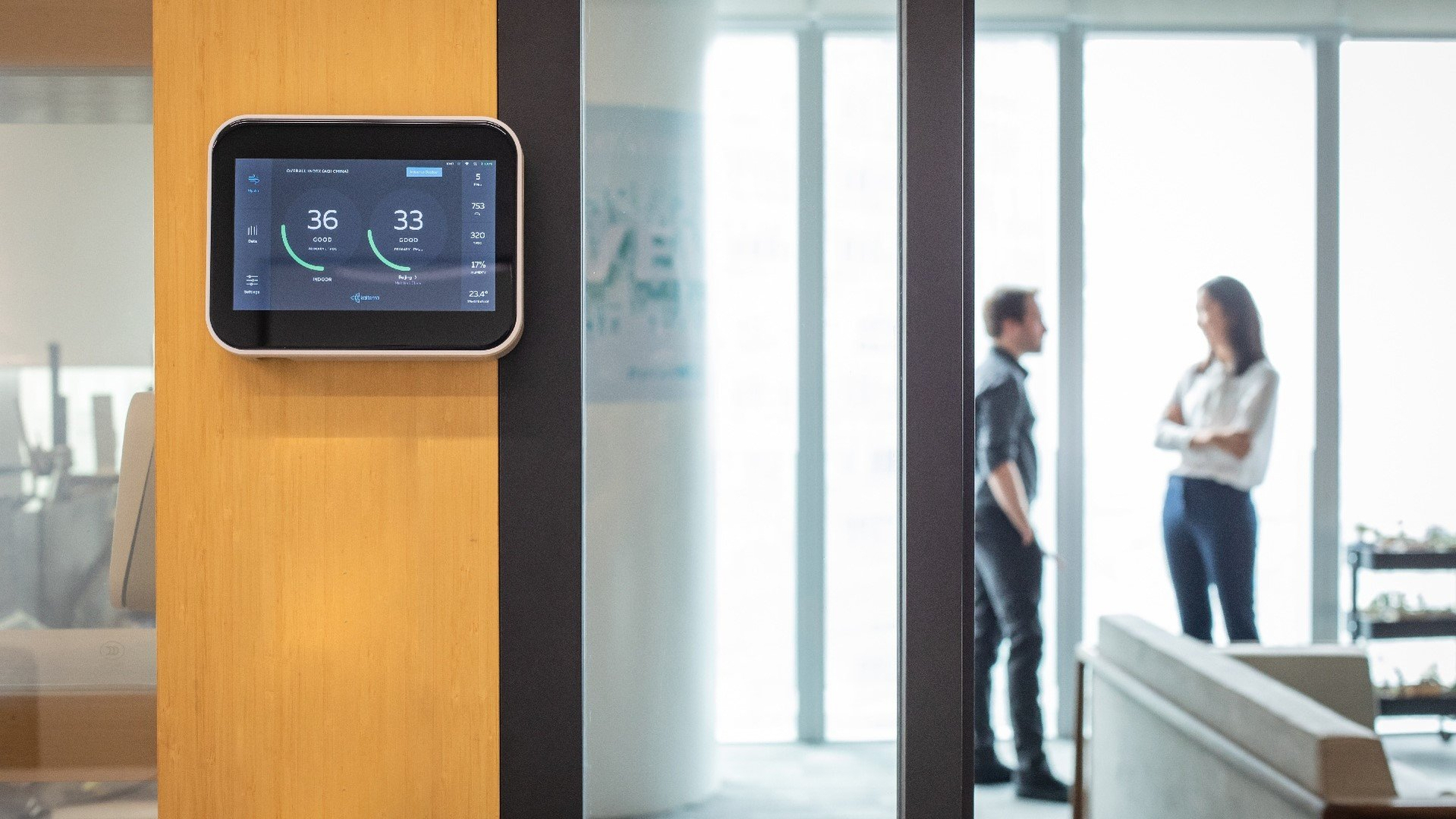Newsletter
You need data to improve processes – but data needs context. While air quality monitors provide valuable information on the levels of parameters such as particulate matter, CO2, and TVOC in a given space, you need to compare your measurement against some ideal state. That's where indoor air quality standards come in: they serve as a benchmark against which you can evaluate your building's air quality and track progress over time. By setting clear goals and striving to meet or exceed these standards, you can take steps to improve the air quality in your building and create a healthier, more comfortable environment for your employees.
In this article, we'll provide an overview of some of the leading indoor air quality standards for evaluating air quality in office buildings - covering international and governmental organizations as well as private certification programs. We'll show what these standards say about acceptable levels of particulate matter, CO2, TVOC, and ground-level ozone, and provide additional information about each standard and links for further reading.
Read more about how to measure and improve indoor air quality in the office here.
Choosing the Right Standard for Your Building
Which standard is most relevant for your office building (or other indoor space)? To decide, you'll need to consider the characteristics of your space and the people who occupy it. For example, you might want to think about:
Location and regulation: Some standards might need to be met in order to comply with local regulations or licensing. For example, the ASHRAE Standard 62.1 is widely used in the United States, but other countries may have their own indoor air quality standards that you need to follow.
Building type and use: Certain standards will be more applicable for specific uses of an indoor space. The IAQ needs of an office building may differ from those of a hospital or a school. Consider the primary use of your building and choose a standard that is designed to address the specific air quality concerns of that type of space.
Certification: Some standards, such as LEED and WELL, offer certification programs that allow you to formally demonstrate your commitment to maintaining good indoor air quality. If you're interested in obtaining certification, be sure to choose a standard that is part of a familiar and respected certification program.
Comparing Thresholds Between Different Standards
The table below summarizes the levels mentioned in each standard for key IAQ parameters (with the idea being that you should aim to keep the measured parameters in your indoor space below the thresholds). We have included both public and private sector standards, including the oft-referenced WHO and EPA guidelines, which refer to ambient (outdoor) air.
It’s important to remember that these are guidelines, not laws set in stone. Often they are used as part of a larger certification system. We highly recommend reading them alongside the additional information we’ve included about each standard below, and using the links to get further information and see whether this standard applies to your situation.
Another caveat to keep in mind relates to TVOC - which, as we’ve explained before, does not have a single clear-cut definition. When TVOC levels are mentioned, it’s important to see which particular compounds are being included - often this would be detailed within the same standard or program.
| Standard | PM2.5 |
PM10 |
TVOC |
CO2 | Ground Level Ozone |
| EPA NAAQS* |
12.0 μg/m3 averaged over one year; 35 μg/m3 averaged over 24 hours |
150 μg/m3 averaged over 24 hours | N/A | N/A | 0.07 ppm averaged over 8 hours |
| WHO* |
5 μg/m3 annual mean; 15 μg/m3 24-hour mean | 15 μg/m3 annual mean; 45 μg/m3 24-hour mean |
N/A | N/A | 100 μg/m3, 8-hour daily maximum; 60 μg/m3 8-hour mean, peak season |
|
EEA* |
20-25 μg/m3 annual mean |
50 μg/m3 daily mean; 40 μg/m3 annual mean |
N/A |
N/A |
120 μg/m3 |
|
ASHRAE 62.1 |
No values given. References EPA NAAQS and other standards |
||||
|
Hong Kong Certification Scheme |
N/A |
20-100 μg/m3 in an 8-hour averaging time |
200-600 μg/m3 |
800-1000 ppm in an 8-hour averaging time |
50-120 μg/m3 in an 8-hour averaging time |
|
WELL |
PM2.5 less than 15-25 μg/m3, depending on outdoor levels |
Less than 35-50 μg/m3, depending on outdoor levels |
Not covered, guidelines for specific VOCs are included |
For demand-controlled ventilatio, 900 ppm or 500 ppm above outdoor levels |
100 µg/m3 [51 ppb] or lower |
|
LEED** |
12 μg/m3 |
50 μg/m3 |
500 µg/m3 |
N/A |
0.07 ppm |
|
RESET*** |
15-35 μg/m3 |
N/A |
200-500 μg/m3 |
600-800 ppm |
N/A |
|
Fitwel |
12 μg/m3 |
N/A |
500 μg/m3 |
1000 ppm |
0.07 ppm |
* The EPA, WHO, and EEA standards are for ambient (outdoor) air quality, but are often referenced in the context of indoor air quality as well so have been included here.
** Refers to the LEED standard for building design and construction (BD + C) and LEED for interior design and construction (ID + C), used for new and existing buildings (respectively).
*** RESET does not provide thresholds but operates on a points system, where points are lost based on a formula that takes into account the distance of the actual measurement from the stated levels.
Additional Information
EPA NAAQS
The US Environmental Protection Agency’s National Ambient Air Quality Standards are meant to protect public health and the environment from the harmful effects of air pollution. While they are primarily focused on outdoor air quality, they can also be used as a reference for indoor air quality, especially in buildings that are located in areas with high levels of outdoor air pollution. The EPA NAAQS are based on extensive scientific research and are regularly reviewed and updated to ensure that they continue to protect public health and the environment.
See the full list of EPA NAAQS
WHO
The World Health Organization (WHO) has established air quality guidelines to provide guidance on levels of air pollution that are safe for human health. The WHO’s guidelines provide recommendations for both outdoor and indoor air quality, including limits for a range of air pollutants such as particulate matter, ozone, nitrogen dioxide, and sulfur dioxide. The WHO also recommends that governments and other organizations implement policies and strategies to reduce air pollution and improve air quality for the health and well-being of their populations.
Read the WHO’s ambient air quality guidelines
EEA (EU)
The European Environment Agency (EEA) has published recommendations for the levels of various pollutants. They are based on the latest scientific evidence and are regularly reviewed and updated to ensure that they reflect the most current understanding of the impacts of air pollution on human health and the environment. The EEA air quality guidelines are widely used by governments, policymakers, and the private sector as a benchmark for setting and reviewing air quality standards and objectives.
Learn more about the EEA’s air quality standards
Hong Kong IAQ Certification Scheme
Established by the Hong Kong Special Administrative Region Government, the IAQ Management Program is meant to promote awareness of the importance of indoor air quality (IAQ) and improve IAQ in general, the. One of the main components of this program is the voluntary IAQ Certification Scheme for Offices and Public Places. The scheme is voluntary and self-regulatory. Building owners have the option to certify the entire building or select locations.
Learn more about the IAQ Certification Scheme
ASHRAE Standard 62.1
The American Society of Heating, Refrigerating, and Air-Conditioning Engineers (ASHRAE) is a professional organization that sets guidelines and standards for the design, construction, and operation of buildings and indoor environments. ASHRAE Standard 62.1 is widely used in the United States. It includes recommendations for ventilation and filtration systems to help improve air quality in buildings, but does not provide specific thresholds for air quality parameters. Informative Appendix E references existing standards including the EPA NAAQS.
Read the full ASHRAE Standard 62.1
WELL
The WELL air quality standard is a performance-based system that aims to improve indoor air quality in buildings and enhance the health and well-being of the people who use them. The standard was developed by the International WELL Building Institute (IWBI) and specifies a set of guidelines and requirements for designing, building, and operating buildings in a way that promotes healthy indoor air. The WELL air quality standard covers a wide range of pollutants and factors that can affect indoor air quality, including volatile organic compounds (VOCs), particulate matter, carbon dioxide, and temperature and humidity levels.
Learn more about the WELL standard
LEED
LEED (Leadership in Energy and Environmental Design) is a globally recognized green building certification program that aims to improve indoor air quality in buildings. Developed by the U.S. Green Building Council (USGBC), the LEED air quality standard evaluates buildings on a variety of criteria related to their environmental impact and sustainability. One of the key areas of focus is indoor air quality, which is assessed based on factors such as the use of low-emitting materials, the implementation of proper ventilation systems, and the use of air filtration technologies.
RESET
RESET (Real-time Environmental Sensing and Evaluation Technology) is a digital certification program used to evaluate and improve indoor air quality in buildings. Developed by the RESET Air Corporation, the standard calls for sensor-based measurements to continuously monitor and measure environmental factors that can affect indoor air quality. RESET also includes guidelines and requirements for designing, building, and operating buildings in a way that promotes healthy indoor air.
Fitwel
The Fitwel air quality standard is a comprehensive system for evaluating and improving the indoor air quality of buildings. It takes into account a wide range of factors that can impact air quality, including ventilation rates, the use of chemicals and building materials, and the presence of pollutants such as particulates and volatile organic compounds. The Fitwel standard is designed to be flexible, allowing building owners and operators to choose the specific strategies and technologies that work best for their particular building and occupants.
Exploring Building Certification?
Kaiterra can help. Discover our continuous monitoring-based solution for building certification to learn how you can streamline air quality monitoring and automate reporting. Need more information? Check out our ebook on IAQ monitoring for high-performing buildings. Need some additional guidance? Get in touch with one of our air quality experts below:






.png?width=200&height=148&name=Menu%20C%20(2).png)

.png?width=307&height=228&name=Menu%20-%20D%20(1).png)
.png)





